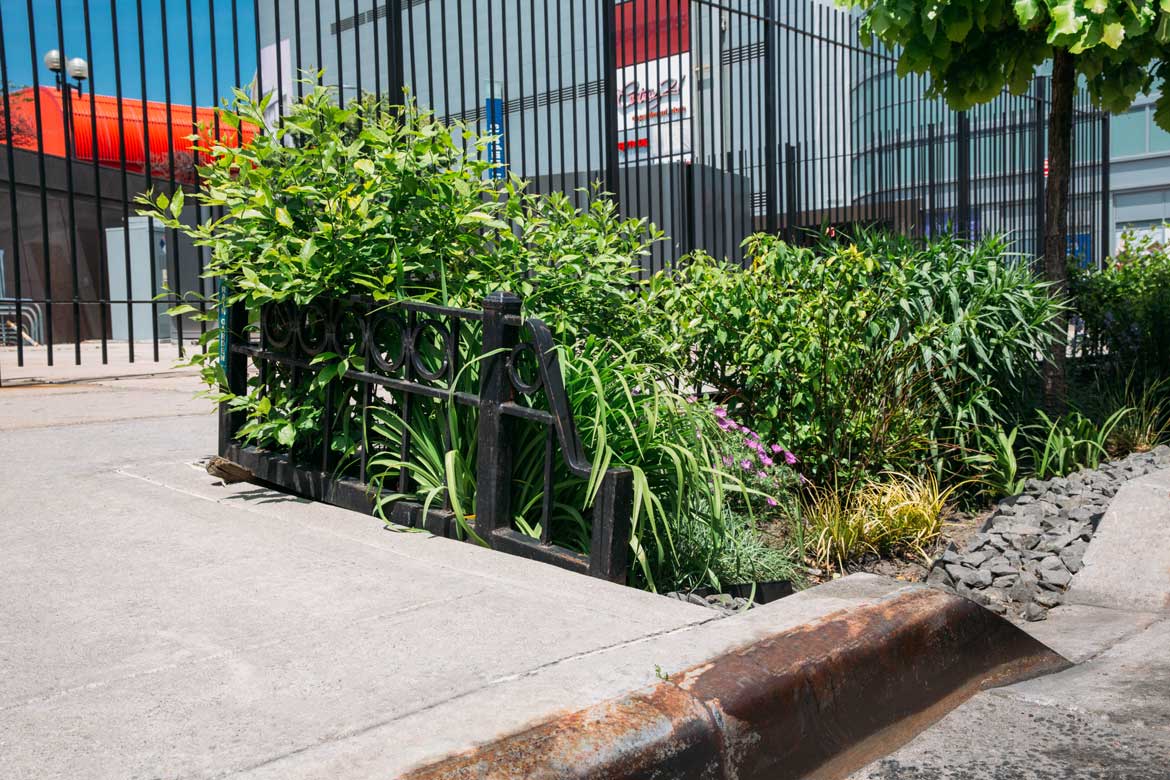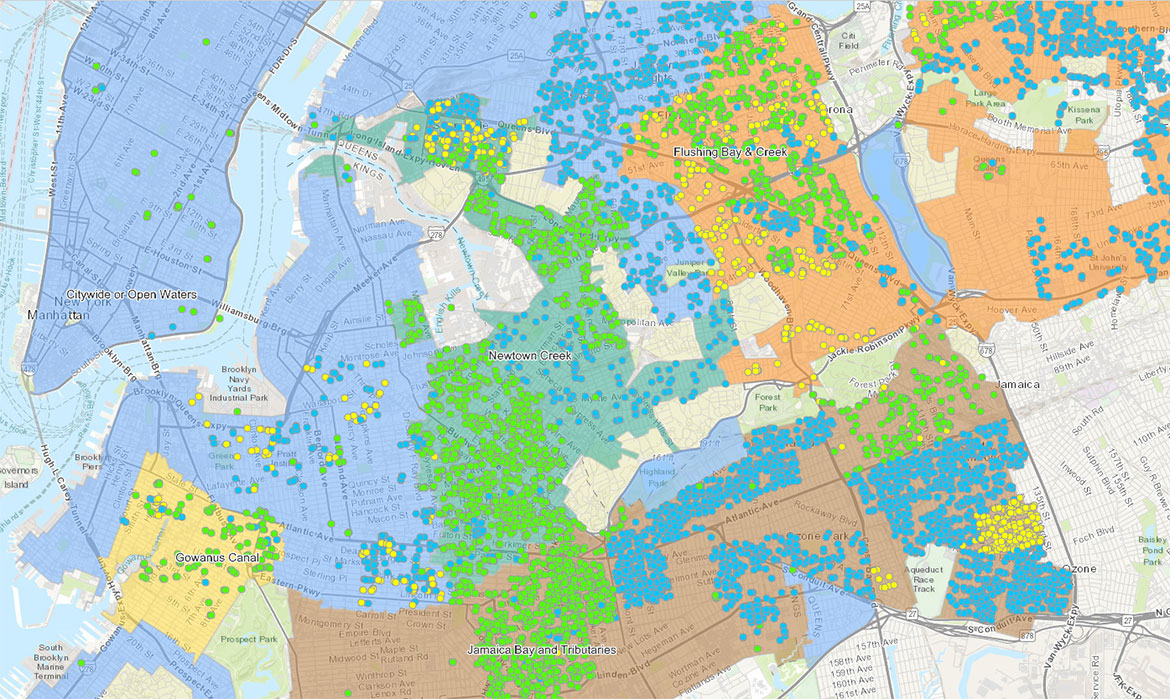
We are celebrating 15 years — and counting — of stories that are deeply researched and deeply felt, that build a historical record of what the city has been.
We are celebrating 15 years — and counting — of stories that are deeply researched and deeply felt, that build a historical record of what the city has been.
In 2017, the New York Times reported on an insurrection against the seemingly innocuous installation of rain gardens in Queens. These small pockets of green absorb and retain stormwater, helping to mitigate flooding and protect water quality across the city’s waterways — a critical element in the city’s climate adaptation plans. But to some Queens residents, they were nuisances, unwanted impositions on the streetscape. This difference of perspective begs the question: as an ambitious green infrastructure plan evolves from pilot projects to citywide system, what does it mean for our daily life and experience of the city?
In heavy downpours, runoff from streets and excess sewage from treatment plants flow into ten combined sewer watersheds, from the Hutchinson River to Jamaica Bay. The climate crisis means more precipitation events and more water flowing over asphalt and into the harbor. The city has installed over 4,000 rain gardens in the last seven years, and more are on the way. Below, writer Ginger Strand checks in on these strange amalgams of sewer and garden, growing from Rego Park to the streets of Bedford Stuyvesant. Under April showers and May sunshine, photographer Jules Slütsky took a look at how the gardens are settling into their varied surroundings. Her photographs, too, are a curious hybrid, revealing other unlikely appearances of green and a complex urban infrastructure both planned and improvised, all facing their own growing pains and calling for tender loving care.
Click the photo above for an image gallery of rain gardens across New York City.
As cities grow, so do their water needs. The engineers who designed the Croton and Catskill water supply systems, starting in the 19th century, had great foresight about New York City’s future drinking water needs. But they gave less thought to wastewater — until its presence caused outbreaks of deadly diseases like cholera. Sewers were hastily built to carry wastewater away into the rivers and bay. Faced with ecological degradation and public health impacts, New York and other cities eventually began treating wastewater. Today, a vast and largely invisible network of pipes carries New York’s sewage to 14 wastewater treatment facilities. Built as an afterthought, the sewers often have to handle storm water too.
Combined sewers are a problem, because New York City’s surface is 72% impervious. When it rains or snows, water flows off streets, sidewalks, and buildings and into storm drains. In over half of the city’s 302 square miles, storm drains empty into wastewater sewers. The sewers can carry up to double the average daily flow of waste, but in heavy downpours, the combined sewage and storm water are more than the wastewater facilities can handle. The excess —including raw sewage, motor oil, and street grime — overflows into our waterways, polluting our rivers and harbor, poisoning marine life, and contaminating our beaches. They can also put the city in violation of state and federal water quality standards. With climate change expected to increase and intensify precipitation events in the region, the problem will only get worse.
Where possible, New York City’s Department of Environmental Protection (DEP) replaces combined sewers with separate ones for wastewater and storm water. But tearing up city streets to replace grey infrastructure like sewer pipes is expensive and disruptive. So DEP has also developed an ambitious plan focused on creating natural systems to take some of the load off the city’s grey infrastructure. Part of the largest green infrastructure plan in the nation, it includes green roofs and rain gardens — swales designed to capture storm water before it enters the sewers. Since 2012, DEP has installed more than 4,000 rain gardens, with another 5,500 going into construction this year.
Although they look a lot like street tree pits, the rain gardens are carefully engineered to divert and hold water during heavy downpours, hurricanes, and nor’easters. Construction crews excavate a pit about five feet deep, then backfill it with stone and engineered soil that lets water seep through. On top, they lay dirt and plant shrubs, flowers, and sometimes trees. The planting includes a curb inlet for water flowing down the street to enter, and larger ones include a low dam, or weir, to control water velocity. Each swale can hold up to 2,500 gallons of water, slowly letting that water infiltrate back into the ground. The rain gardens currently prevent around 200 million gallons of wastewater from entering New York’s waterways every year. And when it’s not raining, they can “green” the cityscape in a larger sense: improving urban air quality, beautifying city streets, and providing shade and greenery that help reduce the urban heat island effect.
Initially called bioswales, these patches of greenery were rechristened “rain gardens” to enhance their appeal as nature. DEP employees use a hybrid lingo in talking about them. On the one hand, they see rain gardens as elements of infrastructure, like a fire hydrant or a street light. They rattle off acronyms like R.O.W. (right-of-way) and S.G.S. (stormwater green street) and give stats on infiltration rates and sediment capture. But they also discuss how hemerocallis is exceptionally hardy and how the native echinacea purpurea attracts pollinators, but doesn’t like wet feet. They stop in the middle of discussing street hydrology to whip out their phones and show photos of a honeybee pollinating a blue lobelia. They plan like engineers but they plant like gardeners.
The rain gardens invite this double vision. If you think of them as micro-ecosystems, you pay attention to a white-skipper bouncing along a chokeberry, and think about the migrating birds who will appreciate that bush’s berries in the fall. You notice a starling following a maintenance crew, searching for bugs in the freshly loosened dirt. But if you think of the rain gardens as infrastructure, you observe the gentle slope that channels water to the center and the row of rocks near the curb that protect plants from people exiting cars. You notice the weir system’s sediment trap. The rain gardens can even start to look like elements of grey infrastructure. A single tree echoes the shape of a nearby streetlight. A low fence frames the sidewalk like a row of Citibikes. The rain gardens’ rectangular shape is reminiscent of both an electrical transformer vault, and the storm sewer drains they are meant to supplement.
Blue signs affixed to the gardens’ tree guards instruct residents to call 311 for more information. Callers are connected to a rain garden hotline to ask questions or report issues. DEP maintenance crews are also trained to answer the frequent queries they get while working. Many residents are surprised to learn that the rain gardens are functional, not merely decorative. “Once we explain it to them, they see it differently,” says Maria Corporan, a Supervisor in DEP Green Infrastructure Maintenance.
Whether the public is welcoming or hostile can depend on the context. In heavily industrialized areas, the swales are rare pockets of greenery. In residential neighborhoods with townhouses or apartment buildings, they read as beautification of the public streetscape. But in the parts of the city dominated by single family homes, the sidewalk is viewed less as a public right-of-way than as part of someone’s front yard. In 2017, the New York Times ran an article about homeowners trying to stop rain gardens from being built near them. Some feared the swales would collect litter or breed mosquitos. (DEP maintains that the gardens hold water no longer than 48 hours.) Residents who pave or plant grass in the city-owned area between sidewalk and street can see the rain gardens as an imposition on their chosen aesthetic. DEP had not anticipated this. In response, they developed new rain garden models topped with grass or permeable-concrete sidewalk that homeowners can now request.
City residents have already begun to make the rain gardens work for them. Tree guards have been recruited as bike racks. Residents have even added plants to the enclosure. (A walk around Sunnyside in May turned up a neat row of unauthorized marigolds.) “I’ve found tomatoes and cucumbers that people planted in them,” says Benjamin Basalla-Taxis, a Community Coordinator with DEP’s Green Infrastructure Maintenance and Bluebelt Operations. He has removed them, explaining to would-be gardeners that it’s not safe to eat vegetables watered by street run-off. Other species have also used them for sustenance. DEP employees have documented hummingbirds, swallowtail butterflies, ladybugs, and honeybees in them. Monarchs have lived out entire life cycles on rain garden milkweed, from eggs to caterpillars to chrysalises and finally to butterflies. The bioswales are a unique hybrid: both sewer and garden.
As the number of rain gardens has grown, DEP has added maintenance employees to care for them. In 2014 they had 15 maintenance workers; in 2018 there were 62. More are being added, with the goal of making sure each rain garden is visited once a week. Water running down the street brings dirt and trash. Sediment must be removed, litter cleaned out, and weeds pulled, along with any self-propagated problem plants. For instance, ailanthus, or tree of heaven, a formerly popular street tree now considered invasive because its fast-growing roots can damage pavement and sewers, has sown itself in the swales. The topsoil must be raked and aerated, and the mix of plants at each location regularly reassessed. Plants that aren’t thriving need to be replaced with new ones. If the rain garden’s environmental conditions change — say a new building shades it — the plant mix must be adjusted in response.
All infrastructure requires maintenance, but grey infrastructure doesn’t beckon residents to take care of it. A broken streetlight means “call 311,” whereas a garden cries out for a gardener. Last year, DEP launched a stewardship program that allows interested homeowners to “adopt” a rain garden and receive training in taking care of it. At a recent event in Bedford Stuyvesant, 25 people from the block association planted 115 plants in eight raingardens. It might be hard to get residents to pick up litter in the subway or empty street trash bins. But if many enjoy helping to maintain a little patch of nature, that might become another benefit of these working organic machines.
All photos by Jules Slütsky.
The views expressed here are those of the authors only and do not reflect the position of The Architectural League of New York.


